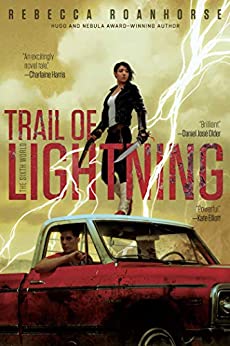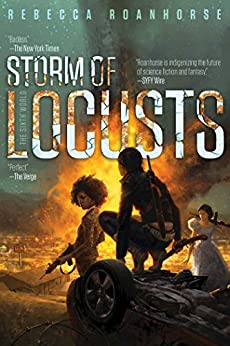Rebecca Roanhorse’s two book series, The Sixth World, is at once a brilliant evocation of the Diné homeland and a strong character study of a young woman who feels stranded between the worlds of human and immortal. She is an antihero at once reveling in and resisting her supernatural powers.

Trail of Lightning and Storm of Locusts have their rough edges and were attacked by Diné (or Navajo) writers for cultural appropriation, but they remain tightly written, fast-paced and strangely moving stories of how Maggie Hoskie endures one trial by fire after another and learns to live with her feelings and her need for other people.
Trail of Lightning introduces Maggie who was forever changed by a past encounter with a god that evoked her powers as a monsterslayer. She has one grandfatherly friend, the elder medicine man Tah, who introduces her to his young and preternaturally handsome student, Kai Arviso.
Kai has his own clan powers, rooted in persuasion and healing, that not only help convince people to see things his way but help Maggie see through the surface masks people wear to their underlying nature. The story turns around encounters with Ma’ii or Coyote and efforts to hunt down a witch who is creating human-killing monsters. Along the way, Maggie gets close to Kai but is always unsure of what she feels, constantly doubting and resisting any deeper feelings she might have for him.

Storm of Locusts takes Maggie outside the boundaries of the Diné homeland as she tracks down the bizarre cult leader Gideon who seems to have kidnapped Kai. When Kai goes missing, Maggie has a clear revelation.
And there it is. Clear as a desert morning. I am not willing to give Kai up. No matter my posturing about letting him come to me, no matter my fears and insecurities. No matter what he’d done in the past. Tah said that Kai was mine now, and it’s true. But what he didn’t say was the other half of that. I am Kai’s. And there’s no way in hell I’m losing him again.
Storm of Locusts, Kindle edition, page 67
Gideon has absorbed the power of locusts, equips his followers with insectile wings and funds his mad plots with human organ transplants and slave auctions. The story takes Maggie and Kai to a near fatal confrontation with Gideon at the edge of Glen Canyon Dam.
Solid adventures, though some of the set pieces seem a bit creaky or extraneous at first. Roanhorse, however, writes her way out of each one quite skillfully.
It is also the story of the Diné homeland. The Diné had already suffered their apocalypse under foreign domination. The Long March from their homeland, the mass killing of their herds during the Great Depression, the forced displacement of their youth to boarding schools are all disasters that remain vivid in the collective Diné memory. So the floods and earthquakes that took off most of the United States came to Dinétah like a rebirth.
To save Dinétah, a great wall had been built to surround the lands within the four sacred mountains. But it went up to a height of fifty feet with supernatural help, each of its four sides made of the colors and materials of the four directions. This world is wonderfully real to the reader, becoming through Roanhorse’s description another character with its own ability to awe and inspire.
Maggie feels the pull of her homeland most strongly when she has to pass the turquoise portion of the wall into the Malpais – the Badlands – the name that fits everything outside her world. She can feel the visceral attraction of the land she is leaving. That is another part of her growth and deepening sense of her humanity.
Above all, these are the stories of Maggie Hoskie’s tortured efforts to understand who she is. Once her killing power emerges, she feels it is the only thing that makes her worthwhile. At times, she is not sure if she is really human anymore but gradually she is forced to get in touch with her human core by the people she meets and the tests she undergoes.
She wins people over at times, seemingly against her will. Like the Goodacre family, the rare non-Diné living within Dinétah. When Grace, the mother, gives her a hug for saving her son, Maggie freezes.
“I stand there, stupefied. Frozen like a deer in the headlights. It sounds pathetic, but I can’t actually remember ever being hugged. I’m sure my nalí did, but that was four years ago if it was a day. … But here is Grace, she of the big talk and the little stature, holding on to me like I mean something.”
Trail of Lightning, Kindle edition, p. 190
Clarissa, Grace’s daughter, has a fraught relationship with Maggie. In one scene, they are literally at each other’s throats. But later they have a joking exchange that establishes their budding friendship quite nicely. I could have used more scenes like that to round out Maggie’s character. On the other hand the few of those human interactions she has she treasures and summons up at the end of Storm of Locusts to remind herself that she is not just a monster or godslayer.
This is one of things that makes Maggie so interesting, not just that she walks this narrow road but that she doesn’t know for sure whether she’ll stay on it or not. That makes the usual insecurities that most people feel much more dangerous in her case. The stakes are always high. She keeps asking whenever she feels the clan powers rising in her if they are taking her too far.
And she goes pretty far with them, killing monsters, wrestling with a god, shooting down crooked lawmen. She admits at one point that she never feels so alive as she is when the supernatural blood lust is surging through her. But something starts to hold her back.
She is forming bonds of love and friendship and need despite her mistrust of her feelings and skepticism about her ability to be human. Through the two books, the strengthening of the human element in her makeup comes to prevail, even as the tasks she has to perform with her clan powers grow more impossible. She becomes better at finding ways to win her battles without killing everyone in sight.
I’m struck by how the internal chaos Maggie experiences about feelings is powerfully universal. Feelings for her can literally lead to killing and blood lust. That is a metaphor for the many people who lock feelings inside themselves because they fear their destructive power if they are released.
I was surprised to find out that Roanhorse, though she married a Diné and lived in Navajo country for some time, is not herself Diné. I understand that this fact led to condemnation from Navajo writers about cultural appropriation. I wonder if that is why, even though Storm of Locusts ends on a note suggesting a possible continuation of the series, she has turned to a much different world in her latest novel, Black Sun. I hope she finds a way to return to Maggie Hoskie because she has created a remarkable character and vivid world. I’d love to know more about them.



Leave a Reply